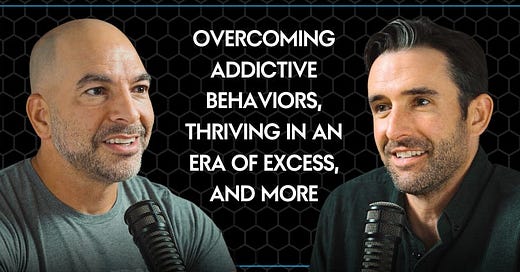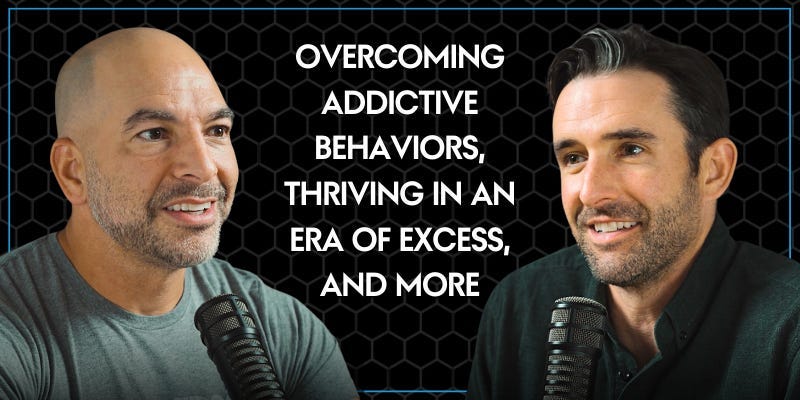We’ll go deeper on three topics that came up in my recent appearance on The Peter Attia Drive Podcast: Nutrition, meaning, and the balance between being social and leveraging solitude.
Housekeeping
Full access to this post and it’s audio version is for paid Members. Become a Member below.
Friday’s post is the January edition of Gear Not Stuff. In our recent poll, you all wanted some garage gym recommendations. So that’s what we’re covering.
I traveled to Austin a couple months ago to sit down with my friend Peter Attia.
Peter is:
A great human being (most importantly).
One of the world’s brightest minds on how to age well. His book Outlive is a must-read.
And his podcast, The Peter Attia Drive Podcast, is killer. You can listen to our conversation on all podcast platforms or watch it on YouTube here:
This post will expand on a few topics that came up in my conversation with Peter. We’ll cover:
The Tsimane diet and the larger point of diet challenges.
How to find meaning in everyday experiences.
How to balance time with people with time alone.
Each will end with a small challenge that helps you flow the ideas into your life.
I’d also love to hear your thoughts on the topics. Comment how your own experience with these ideas has helped you—so we can all learn more.
The Tsimane diet and the larger point of diet challenges
In short
Trying different diets can give you tactics that help you find your own way of eating.
The details
The best diet is one that’s healthy and enjoyable—and that you can stick to for the long haul.
But then the question is, how do you actually find that diet?
Peter opened the podcast by asking me about the Tsimane. We covered the tribe, the research around them, and what they eat.
But once the mics were off, Peter asked me questions about the Tsimane diet. How to do it. What foods the tribe eats and doesn’t eat (for example, do they salt their food?).
If Peter is interested in trying the diet, I assumed others would be too. So I decided to run a free two-week Tsimane Diet Challenge. You can sign up here:
Get the Tsimane Challenge Here
We covered some light details on the tribe and diet in Monday’s post (read that post here if you missed it). Sign up for the challenge to get all the in-depth information and tactics.
The Tsimane diet is rather rigorous for the average person.
The Tsimane eat entirely single-ingredient foods they hunt, fish, raise, grow, or gather. Trying their diet at home means you’ll have to eat entirely single-ingredient foods. And not douse your food in flavor enhancers like oil, sauces, and salt.
Today, roughly 75 percent of our food system is based around ultra-processed foods.
The benefit of trying different diets
Eating like the Tsimane was new to me when I tried it for a month. But it was killer effective. I lost weight (even though that wasn’t the goal).
I found some of the other benefits even more powerful: Improved sleep, better focus and performance, etc.
I didn’t eat like the tribe forever. That would be a pain in the butt.
But that doesn’t mean I returned entirely to my old way of eating. The lessons I learned from the diet changed my “normal diet” forever. And that, I think, is the handle on diet challenges.
Challenges give you a new path for a brief time. What you learn on that rigorous path changes and improves your existing path.
I now eat far more single-ingredient foods. For example, my lunches and dinners on any given Sunday through Thursday are mostly what I ate when I went all in on the Tsimane diet.
And I now have a different viewpoint on many foods I once thought were healthy. Like, say, protein bars.
I also now realize I feel better when a greater ratio of my diet comes from whole carbohydrates. These insights help me land on a sustainable way of eating.
The science of diets
To understand how people respond differently to diets, consider a famous 12-month study that compared weight loss among people on a high-carb versus low-carb diet.
Statistically, the diets were equal. The average weight loss during the trial was 12 pounds for both diets. But that’s just an average.
Each group contained people who lost and gained far more weight than expected. Some participants lost 66 pounds while others gained 22.
This suggests that:
We know a lot of general guidelines about diet.
But that diet is very individual.
The common guideline running between diets that work: They rely on minimally processed foods. How you mix and match those foods is up to you.
A challenge for you:
Write down the last diets you’ve tried. Now list what aspects of each diet did and did not work for you.
From there, consider your current way of eating. How can you flow the good lessons from past diets into your everyday diet?
This exercise sounds simple. But when people quit a diet, they often fully return to their old way of eating.
This is called the disinhibition effect. But it prevents the critical point of trying a diet: the learning.





